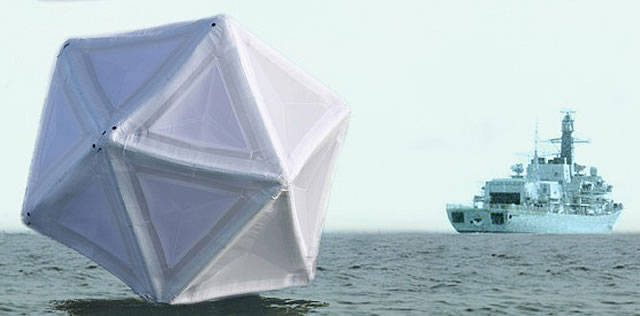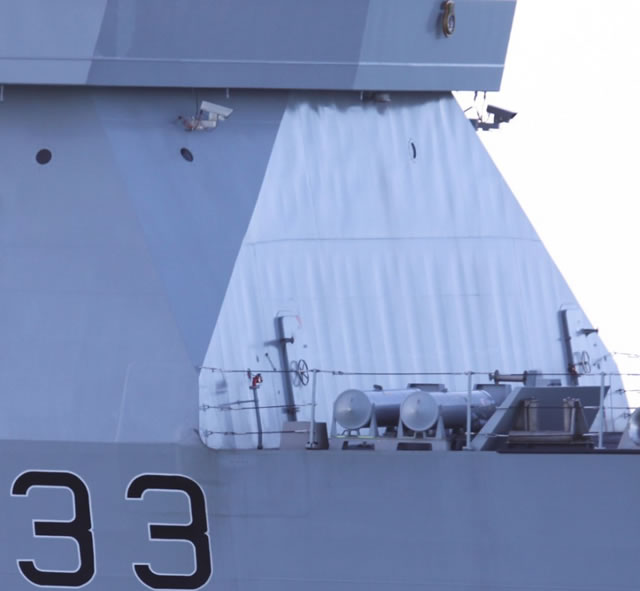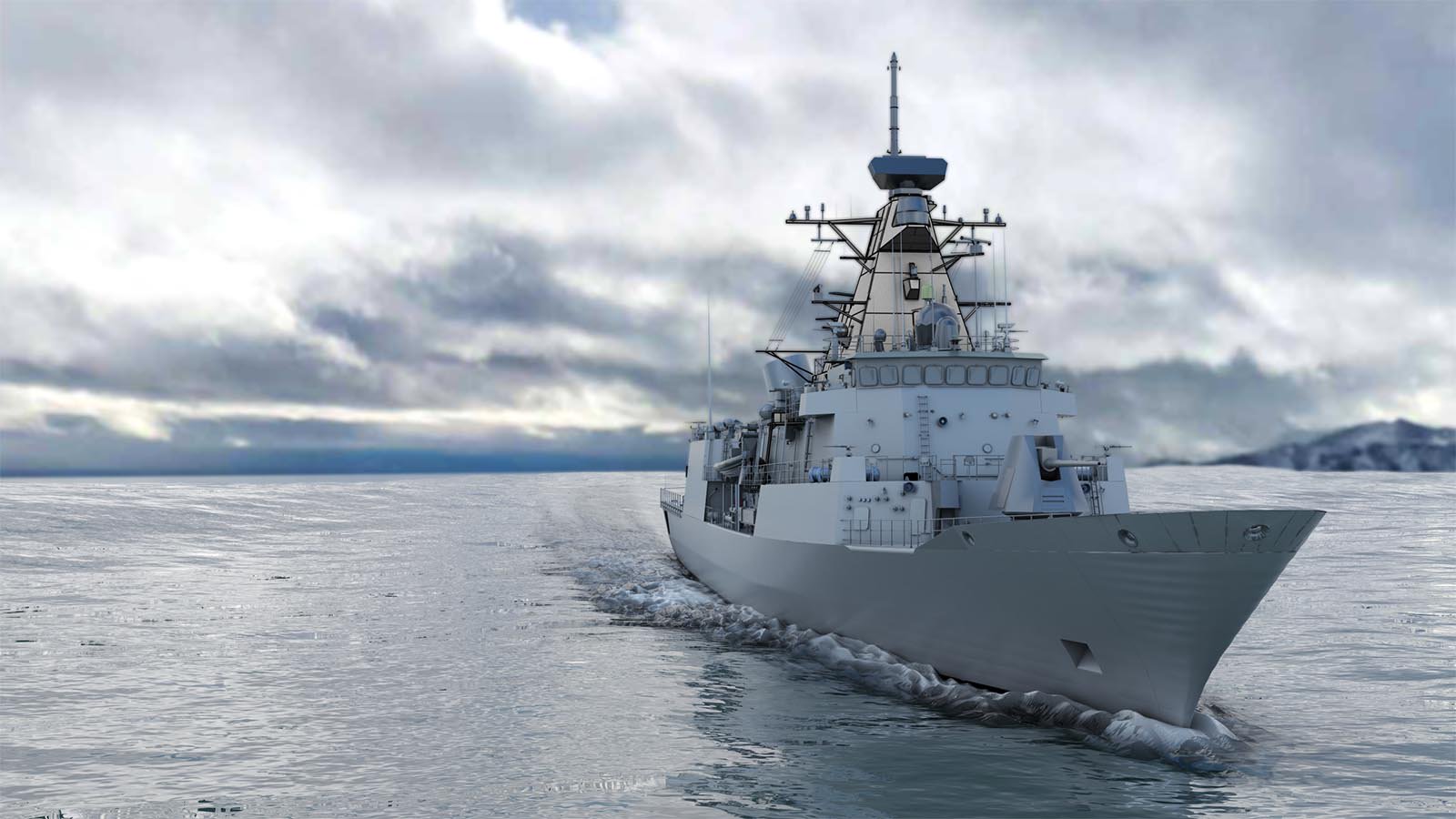Airborne Systems Europe is pleased to announce that the Royal New Zealand Navy (RNZN) will join their counterparts in the UK Royal Navy and United States Navy in fitting the Airborne Systems FDS3 decoy systems to their ships. The FDS3 corner reflector decoy offers a unique countermeasure protection against the most advanced and latest RF-seeking missiles.
The contract to supply the system is valued at £3.4 million over the next three years and will see the system fitted to the RNZN frigates as part of the ANZAC class Frigate Systems Upgrade (FSU) project. The contract for the decoys was awarded on 3 July 2014 at the New Zealand Ministry of Defence offices in Wellington, New Zealand.
 The FDS3 decoy on the sea surface
The FDS3 decoy on the sea surface
“The New Zealand Ministry of Defence has identified the capability that the FDS3 can provide against the proliferation of advanced missile threats that are emerging globally. The award of this contract is a proud achievement for Airborne Systems,” says Chris Rowe, President of Airborne Systems Europe.
The NZ MoD’s FSU Project Director, Gary Collier, said at the contract award ceremony, “We are delighted to have negotiated this contract, and the FSU Project team is very much looking forward to working Airborne over the next few years. We’re proud to be the first customer outside of the UK and US, for this generation of the system, and believe the decoys provide an important adjunct to the overall anti-ship missile defence capability of our frigates and I know the RNZN is very pleased to be getting the FDS3 system”.
Peter Barrett, the Airborne Systems Business Development Manager for naval decoys adds,
“The FSU programme has allowed the NZ MoD to examine the range of naval anti-missile countermeasures in the marketplace, and which ones are most effective against the latest RF seeker technology. The selection of the Airborne Systems FDS3 corner reflector decoys recognises the fact that with the emergence of more advanced threats, navies will have to re-examine their strategies for defeating RF missiles, as the more traditional countermeasures that have been utilised for many years, will be increasingly ineffective against these latest missiles. The FDS3 system offers an effective solution against these advanced threats”.
- Ultra Electronics to Supply Sea Sentor Torpedo Defence systems to Royal New Zealand Navy
- THALES TO EQUIP NEW ZEALAND'S ANZAC FRIGATES WITH SMART-S MK2 RADAR
- Is CAMM the right air defence for the Royal New Zealand Navy?
Airborne Systems corner reflector decoys have been fitted to the UK Royal Navy frigates since 1986, with the latest version for the UK Royal Navy entering service in 2006, and also being fitted to their latest Type 45 destroyers.
In September 2013, Airborne Systems announced a contract award with the US Navy (USN) worth $41.7m to supply a USN variant of the FDS3 decoy system (Mk59), for fitment on USN frigates, over a 5 year programme. Other NATO nations have also fitted various versions of the decoy system onto their vessels.
The decoy system itself comprises of deck-mounted launch tube, which is already preloaded with the decoy, and upon pressing the fire button in the Ops room the process then becomes fully automatic. The decoy is launched out of the tube, and fully inflates alongside the ship’s hull on the sea surface, before automatically being released and free floating past the stern. This entire deployment and inflation process takes a very short period of time, making the FDS3 system effective against supersonic threats.
“This contract further confirms the position of Airborne Systems as the world leader in naval corner reflector anti-missile decoy technology. This NZ MoD contract follows on from the success of the $41.7m US Navy contract in 2013. In addition to providing protection for the forces of our allies, it sustains high-quality jobs in the UK, and more particularly in South Wales.”
“The FDS3 decoy system is one of a number of electronic warfare decoy products being designed and manufactured by Airborne Systems’ UK facility, and represents a growing market,” states Chris Rowe.

The NZ MoD’s FSU Project Director, Gary Collier, said at the contract award ceremony, “We are delighted to have negotiated this contract, and the FSU Project team is very much looking forward to working Airborne over the next few years. We’re proud to be the first customer outside of the UK and US, for this generation of the system, and believe the decoys provide an important adjunct to the overall anti-ship missile defence capability of our frigates and I know the RNZN is very pleased to be getting the FDS3 system”.
Peter Barrett, the Airborne Systems Business Development Manager for naval decoys adds,
“The FSU programme has allowed the NZ MoD to examine the range of naval anti-missile countermeasures in the marketplace, and which ones are most effective against the latest RF seeker technology. The selection of the Airborne Systems FDS3 corner reflector decoys recognises the fact that with the emergence of more advanced threats, navies will have to re-examine their strategies for defeating RF missiles, as the more traditional countermeasures that have been utilised for many years, will be increasingly ineffective against these latest missiles. The FDS3 system offers an effective solution against these advanced threats”.
Airborne Systems corner reflector decoys have been fitted to the UK Royal Navy frigates since 1986, with the latest version for the UK Royal Navy entering service in 2006, and also being fitted to their latest Type 45 destroyers.
In September 2013, Airborne Systems announced a contract award with the US Navy (USN) worth $41.7m to supply a USN variant of the FDS3 decoy system (Mk59), for fitment on USN frigates, over a 5 year programme. Other NATO nations have also fitted various versions of the decoy system onto their vessels.
The decoy system itself comprises of deck-mounted launch tube, which is already preloaded with the decoy, and upon pressing the fire button in the Ops room the process then becomes fully automatic. The decoy is launched out of the tube, and fully inflates alongside the ship’s hull on the sea surface, before automatically being released and free floating past the stern. This entire deployment and inflation process takes a very short period of time, making the FDS3 system effective against supersonic threats.

Artist 3D model impression of a New Zealand ANZAC Frigate after her upgrades. You can see the launch tubes below the bridge wings.




